The popularity of succulents has seen them become one of the top-selling plant variants over the last couple of years. It’s no wonder considering they are low maintenance and surprisingly inexpensive.
However, do succulents attract bugs?
Yes, the succulents are not immune to all pests because some bugs are attracted to them. However, they also feature resistance to a lot of pests due to their ability to purify the air.
These plants have a high water concentration stored within their leaves and stems. Certain bugs use succulents as a source of hydration when there is nothing else on offer to them in the near vicinity.
One of the biggest providers of moisture for bugs is any leftover water from succulent soil.
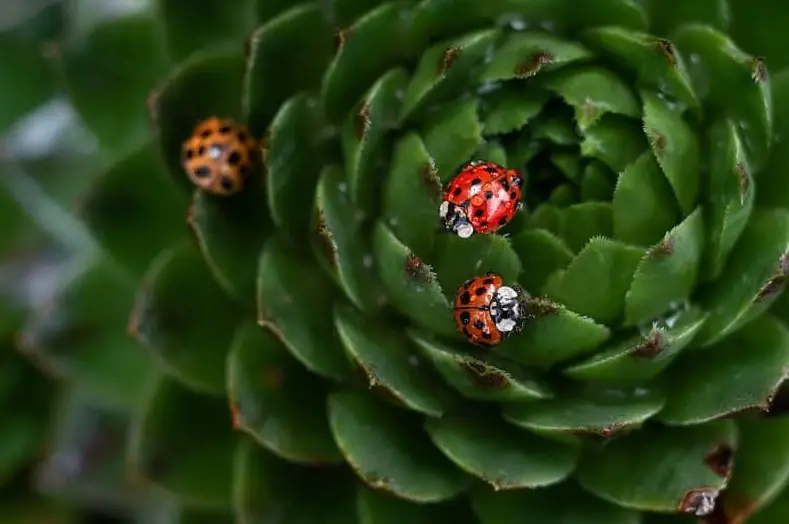
That’s why it’s very important to not over-water a succulent. You will just leave the door open for bugs to come and go as they please. The more bugs that hang around and use this water supply, the greater chance your plant has of becoming destroyed by the bug.
Let’s face it; they don’t just sit there and sip on it like it’s a tea party. They also eat away at the plant, making them susceptible to fungal and bacterial infections.
Table of Contents
Do Succulents Attract Bugs?
In short, yes! Succulents offer an abundance of much-needed hydration to various pesky insect species.
Bugs such as mealybugs, scale, spider mites, fungus gnats, aphids, ants, whiteflies, vine weevils, slugs and snails love sucking as much moisture as they can out of them.
In the process, they can also make a real mess of your plants. Often, the plant can become so ruined that it can’t be revived.
One of the best ways to deal with these little buggers is to not give them any reason to be there in the first place. That’s easier said than done, though.
The toughest challenge with succulents is providing them with the right water. Not enough will dry them out, and too much will drown their roots, causing root rot. It’s a real balancing act already, let alone trying to also deter bugs from hanging around.
A good method to test the moisture level is to dip your finger or a skewer or something like that into the soil and make sure that it isn’t bone dry or so wet that the soil clumps together.
Regular checks are essential. In general, succulents are, in fact, low maintenance, but this small detail is quite important.
Bugs that Are Attracted to Succulents
Several different bug species can do much more damage than others. Some attract mold growth, and others make the plant susceptible to fungal and bacterial infections.
Regardless of their ability to damage, if they are not discovered and mitigated early enough. You can usually find them up the spine or in clusters along the plants’ veins.
Some of the worst offenders include:
Mealybugs
Appearance
Mealybugs aren’t the smallest pests, but they can do some real damage. They can usually grow upto ⅓-⅕ of an inch long. They are white and almost look like a cotton textured blob of wax. They are one of the easier pests to remove due to their slow speed, significantly decreasing the chance of evasion.
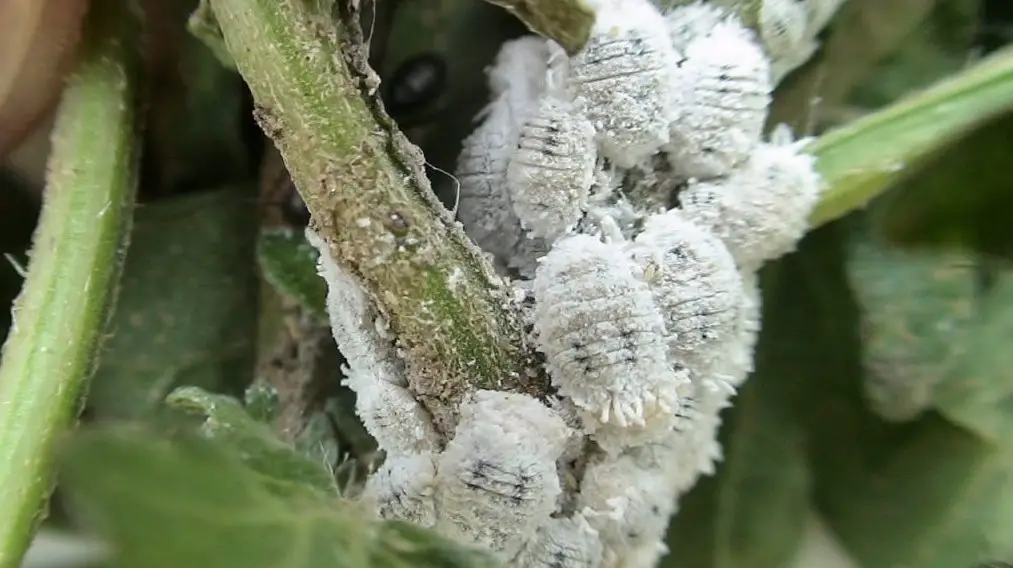
Symptoms/Affect
This bug can damage succulents by sucking the moisture out, which weakens everything from the roots to the leaves. The plant will appear to become shriveled as it produces wrinkles. If these pests aren’t dealt with, they will suck the life out of a succulent plant and kill it.
The first sign of these intruders is the sticky residue, black mold or a cotton-type substance that they leave in various spots of the plant, depending on how much they have managed to destroy. The bi-product of consuming the succulent’s moisture is a sugary goo which can stimulate mold growth.
Treatment
Rubbing alcohol, neem oil, peppermint oil, removing affected parts
Scale
Appearance
Scale insects look like small cotton-like shells. They are slow and easy to spot.
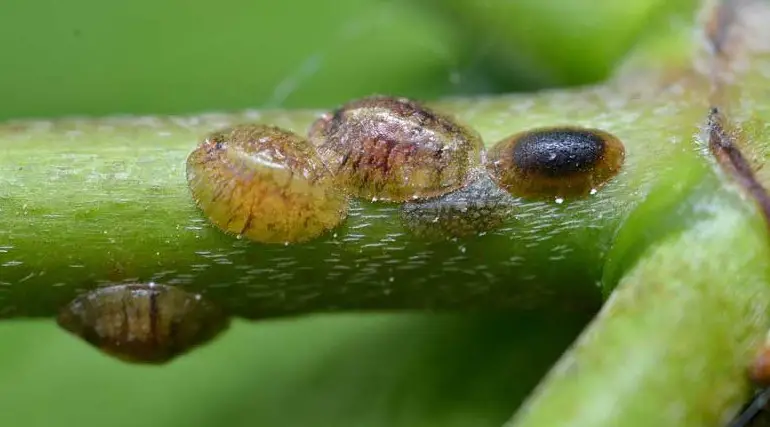
Symptoms/Affect
You can usually see them latched onto the plant’s leaves and/or stems. Scale also attaches to the plant’s tissue so tight that they cause scarring when removed. They use the same methods of submission as mealybugs. They feed on the plant’s juices, causing them to wither up and wrinkle.
A common sign that you have a scale infestation is the small brown bumps they create while feeding. These pests don’t like the sun’s heat, so they like to hide either on shadier parts of a plant or on the underside of a fat, juicy leaf where they can feed without breaking a sweat.
Treatment
Removing affected parts, store-bought insecticides/pesticides.
Spider Mites
Appearance
Spider mites are tiny, borderline microscopic. They measure around 1/50 inch in length and often get around without being able to be spotted. The most common type of spider mites is browny/red.
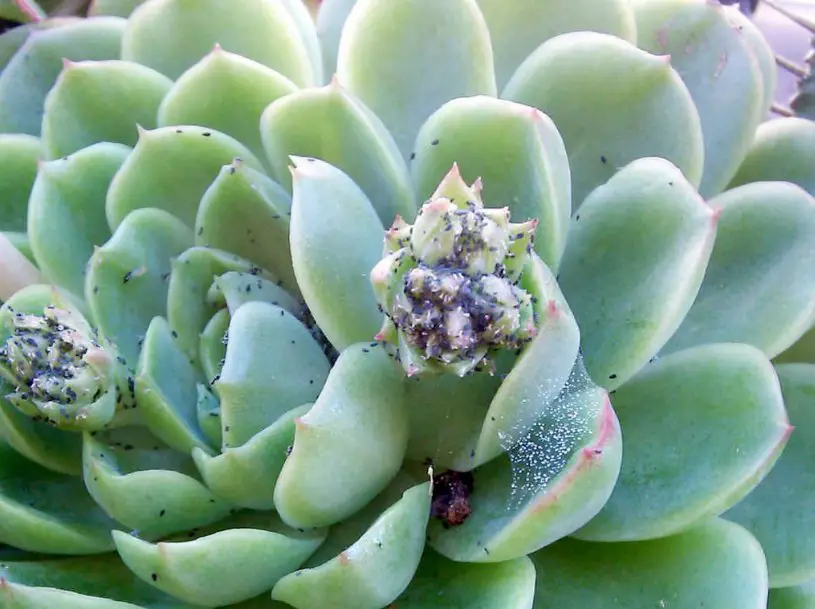
Symptoms/Affect
These almost invisible little buggers also like to suck the plant dry. As a result, it loses almost all of its moisture which causes it to shrivel up and wrinkle.
A warning sign of spider mites is the way that the plant starts going pale and almost turns silver to white color. They also began their attack by releasing webbing and causing small brown dots to appear.
Treatment
Soapy water, neem oil, peppermint oil, removing affected parts
Fungus Gnats
Appearance
Fungus gnats are much easier to detect. They almost look like a fly cross mosquito hybrid with a longish body. They grow to around ⅛-1/16 of an inch in length.
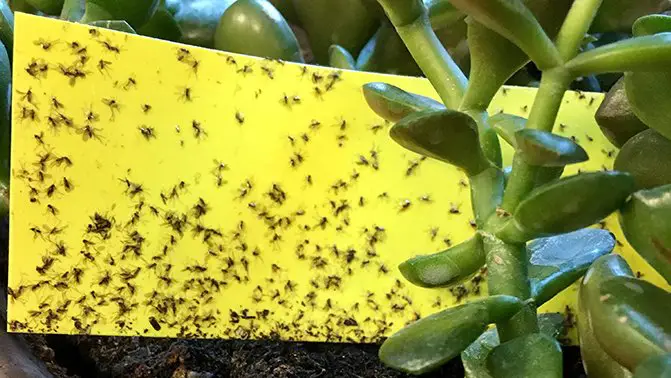
Symptoms/Affect
They are usually found hovering above the soil as it is the perfect breeding ground for them. The larvae often nestle down under the soil, using the organic matter and root system as food sources. A succulent plant can become stunted due to the root system being disturbed. Overwatering the plant will attract the gnats to the moist soil.
Treatment
Removing affected parts, store-bought insecticides/pesticides.
Aphids (Green flies/plant lice)
Appearance
A common aphid is pale green, and its body shape can resemble a teardrop.
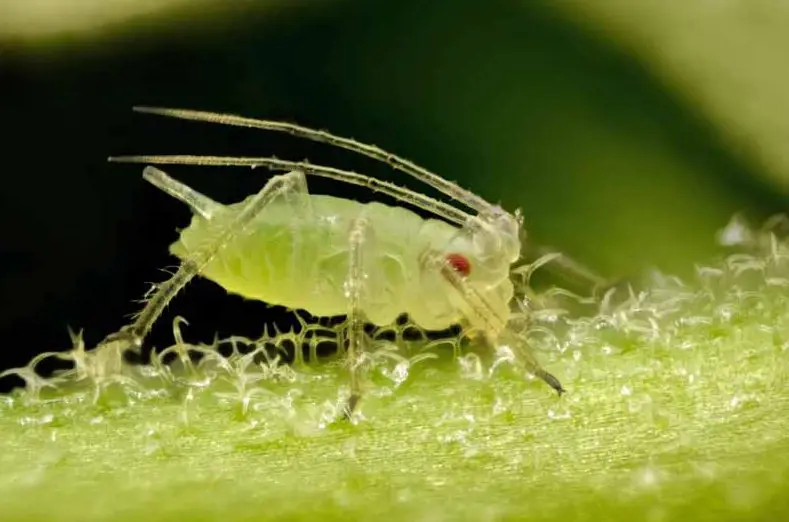
Symptoms/Affect
They use the leaves and flowers as their primary food source and leave a sticky white substance behind as they move around. This substance sticks to the affected area like glue and causes a dark mold to appear.
They are more attracted to the softer, lush parts of newly grown plants like seedlings. As they latch onto the tissue of the plants’ leaves, they cause distorted leaves and stunted growth.
Treatment
Rubbing Alcohol, soapy water, neem oil, and peppermint oil, removing affected parts.
Ants
Appearance
The main culprits are the common black ants found in the garden.
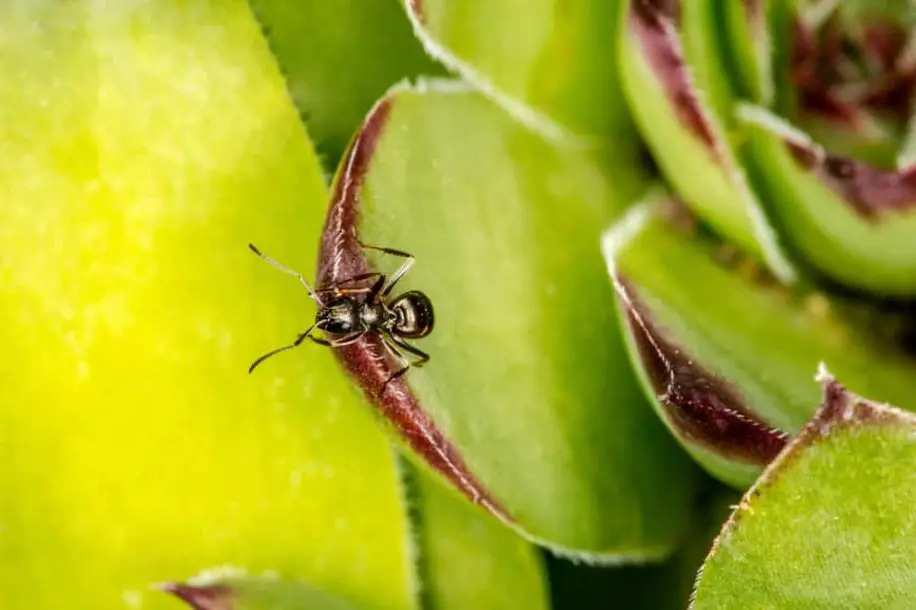
Symptoms/Affect
Ants are attracted to mold in the soil, so if the plant has too much water, chances are, you will find anywhere from a couple to an army of ants. Ants also love the sugary substance and any carcass left behind by aphids, scales and mealybugs. So if you’ve had any of those insects roaming around for a while without removing them, the ants will be your next problem.
Treatment
Removing affected parts, store-bought insecticides/pesticides.
Whiteflies
Appearance
Whiteflies look exactly as their name states; they are white-coloured flies resembling moths but close enough. It’s hard to spot them, though, as they are a mere 1.5 mm long.
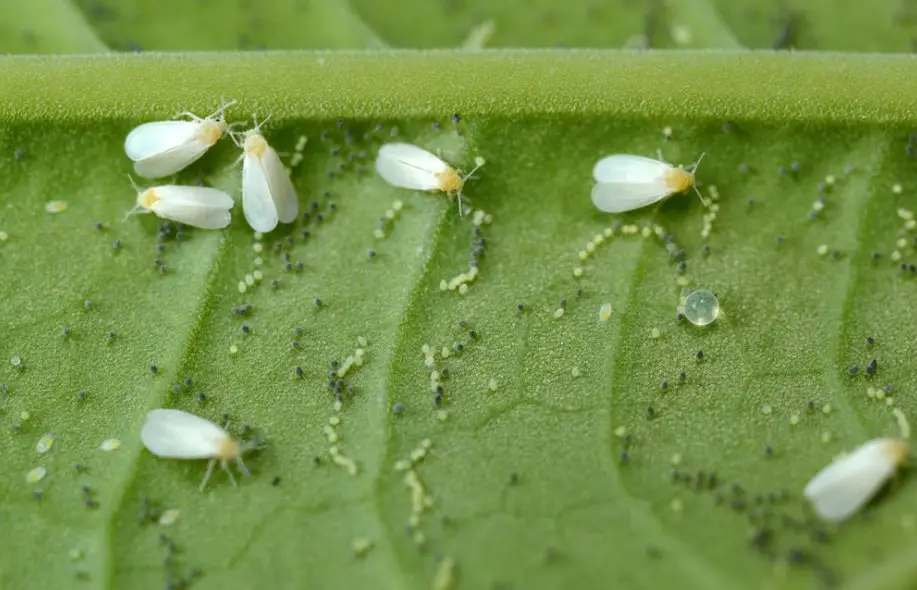
Symptoms/Affect
Whiteflies hide amongst the leaves of a succulent plant and excrete a yellowy-white sticky substance that becomes black mold once it establishes itself. They suck out all of the sap from the plant, which causes them to shrivel up and die after a while if left untreated. They are tough to eradicate as they can multiply super fast. They need to be attended to at first sight.
Treatment
Rubbing alcohol, removing affected parts, store-bought insecticides/pesticides.
Vine Weevils
Appearance
Vine Weevils are dull and black and have speckled yellow markings on their wings. They grow to just under a centimetre in length. They usually hide in spine crevices of a leaf or on the underside, away from any larger intruders.

Symptoms/Affect
It’s quite common to see small notched/nobby areas on a succulent stem as the weevil feeds. The grub weevils are a much bigger problem than the adults as they feed on a plant’s roots. This leaves the plant unable to source its nutrients from below the soil.
As its food supply is cut off, the succulent will slowly die from starvation. An even greater problem is the speed at which these pests can reproduce. The female can lay hundreds of eggs per season.
Treatment
Removing affected parts, store-bought insecticides/pesticides.
Slugs and Snails
Appearance
Slugs and snails can come in various forms and colors, from pale white shells to green and even red. They are very easy to spot due to their size.
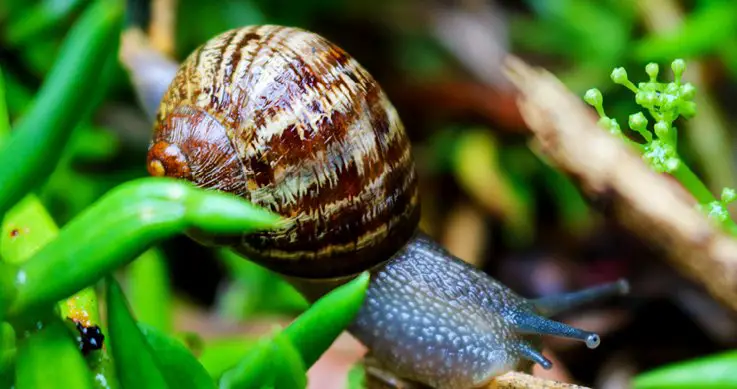
Symptoms/Affect
You’ll know when slugs and snails are about because their main attack is to eat almost everything. They snack on the leaves, the stems and even the fruits. They leave holes everywhere, and the half-eaten fruits rot out, causing fungal and bacteria issues.
Treatment
Removing affected parts, store-bought insecticides/pesticides.
How to Keep Bugs Off Your Succulents?
There are several ways that you can either prevent any small pests from coming near your succulents or even wipe them out when they start to become a problem.
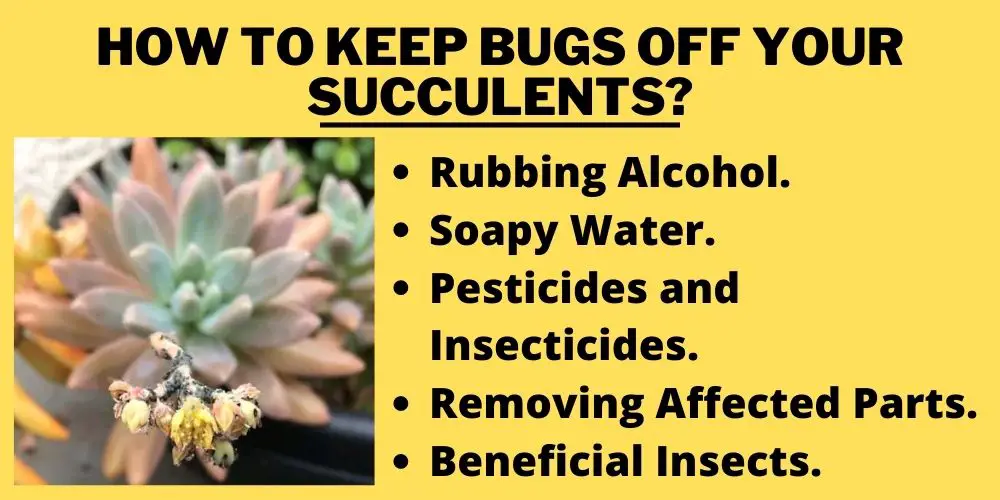
Some require reactively using certain substances. Other methods are a little more proactive with a healthy plant environment. Some of the best ways to help keep bugs off your succulents are:
Rubbing Alcohol
Rubbing alcohol is an easily available and inexpensive substance that won’t harm your plant but can take out any nasties if used correctly. This process will burn the bugs with its 70% alcohol concentrate.
You can use rubbing alcohol with almost 100% results in a few different ways. Rubbing alcohol is especially effective against aphids, whiteflies and mealybugs.
- Firstly, you can mix a diluted solution of 1 part rubbing alcohol to 9 parts water.
- Using a cotton swab, dip into the solution and apply it directly to the bugs.
- Alternatively, add the solution to a spray bottle and spray the affected areas.
- Wait 2-3 days and check to see that all insects are destroyed.
- Give the succulent a gentle rinse to remove any excess residue and bug matter.
Soapy Water
Another slightly less brutal but equally effective remedy is soapy water. This solution will dry out most bugs leaving them to die in only a short period. Soapy water is quite successful against aphids and spider mites.
- Simply mix a solution with 5 tablespoons of dishwashing liquid to 4 cups of water.
- Add the blend to a spray bottle and test the affected area first. This means giving it a couple of sprays and then waiting 2 days to ensure it wasn’t too harsh for your plant. Not only that, but check if it is affecting the pests.
- Judge the level of damage and adjust the mix accordingly. If the plant wasn’t harmed and the bugs still seem to hang around, add an extra half tablespoon of dishwashing soap at a time.
- Spray the affected area again once you’re satisfied it is working, and wait 2-3 days to check on the results.
- Give the plant a gentle rinse and remove any dead bugs.
Pesticides and Insecticides
Using any type of pesticide or insecticide can be harmful depending on the succulent species. There are many available to purchase but to be honest, I have had great success with a simple acidic water solution that you can mix up yourself with relative ease.
It’s less harmful to your plant and packs a punch against almost all plant-sucking insects.
- Mix a solution of 1 part vinegar to 3 parts water with a few drops of dishwashing soap.
- Add it to a spray bottle and spray the affected areas.
- Wait 2-3 days to see results.
- Gently rinse your plant off any dead insects or residue from the solution.
Alternatively, you can purchase pre-mixed solutions such as this peppermint oil or neem oil, which aren’t far off being completely natural. Otherwise, if you don’t mind going full rambo on the bugs, there are blends such as this Earth’s Ally product. These selections are super effective against spider mites, aphids and mealy bugs.
Removing Affected Parts
If the products above do not have the desired effect or are, but parts of your succulent are still damaged, you can remove certain areas altogether. The best way to do this is to identify the lowest affected point and trim it off with a clean, sterilized tool such as scissors or pruning shears.
Once the part is removed, it’s a good idea to give the plant a decent rinse to ensure any damaged parts are completely detached from the plant. When you are satisfied, treat the plant with one of the above solutions to keep any more intruding pests away.
There is always the possibility that the damage is too far gone, and the plant must be disposed of. If so, remove it completely away from any other plants and dispose of it carefully. Any other plants in the vicinity can also become affected if you are not careful.
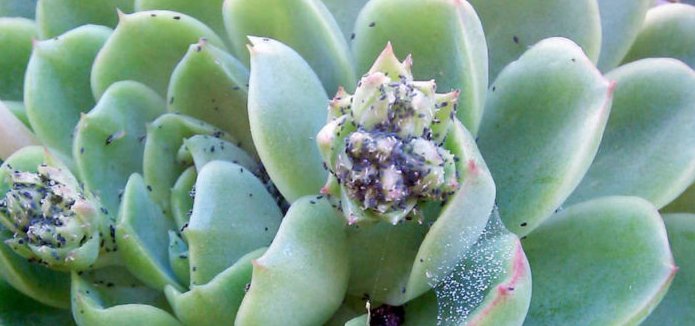
Beneficial Insects
One of the least invasive methods of eradicating bugs is by, erm, attracting new bugs. This sounds crazy, but there are certain bugs like the aphid midge, ladybug, hoverfly, braconid wasp, damsel bug and ground beetle that will go to town on the pesky ones.
The simplest way to attract beneficial bugs is by planting flower herbs and wildflowers within the vicinity of your succulents. Some other great choices of attractive flowers include alyssum, sunflowers, yarrow, coneflower, calendula and cosmos.
Each plant type has a range of subspecies adored by the good insects. Sometimes it’s better to create a proactive environment of harmony instead of reactive.
4 Ways to Know If Your Succulents Are Infiltrated With Bugs
Depending on what is attacking your succulent, they won’t do a good job covering up their crime. Most bugs will leave some evidence in the form of a substance or mark that can be easily distinguishable.
Some notable ways you can confirm that your succulent has been infiltrated by bugs include.
- Finding small brown spots and/or bumps – Scales generally cause these. They eat the sap of the succulent, which harms the plants’ ability to heal, leaving them susceptible to disease.
- Waxy secretions – Most bugs leave a wax-like substance behind as they destroy a succulent. It is generally found on the leaf or stem and is easy to spot. It should be removed as soon as practical.
- Shriveled/wrinkled leaves – This signifies that the intruder has been having a nice feed and left very little for the succulent to live off.
- Black Mold – If you find areas of black mold, it’s usually a sign that the sticky residue that most pests leave has been attached for too long. If the mold is not treated once spotted, it can dramatically affect the plant.
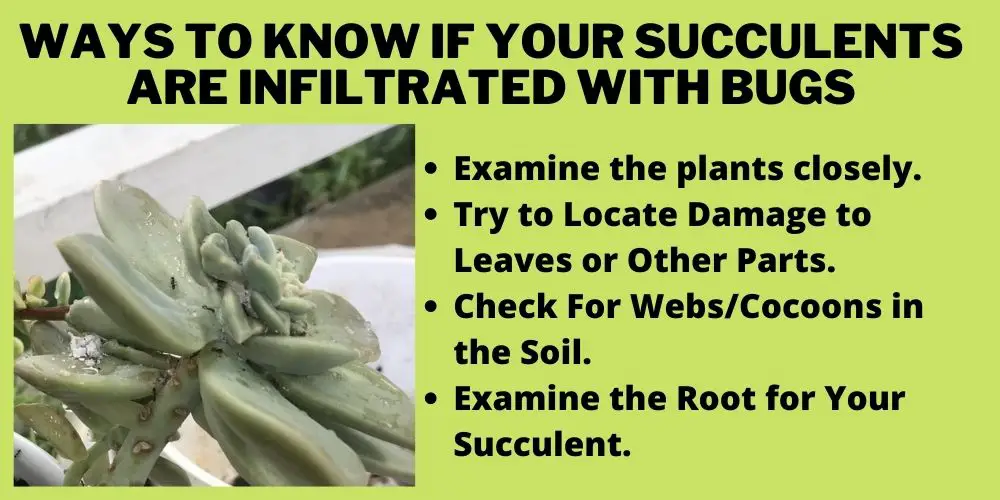
There are some counter approaches that you can take to try to be on the front foot before any damage can get too out of hand. These include:
Examine the plants closely
Have a really good look at your succulents regularly. Aim to check on them at least once a week. If you see any sign of bugs, then you will give your plant the best chance at survival by treating them on the spot. They won’t have time to move around, secrete their gooey substance or respawn at will.
Try to Locate Damage to Leaves or Other Parts
This will sound a bit repetitive, but it’s worth combing through the whole succulent plant to check for any sign of infiltration. Check all leaves, including underneath, and have a good look at the stems as well as the roots if possible.
If there is damage elsewhere on the plant, it should get treated on the spot or removed completely to reduce the risk of infecting the rest of the plant.
Check For Webs/Cocoons in the Soil
Webs and cocoons are a horrible sight. It means that not only do you have bugs making a mess of your succulents, but they have also reproduced, and you will more than likely end up with many more little bundles of joy.
Aim to first remove the webs and cocoons to minimize the damage they can cause.
Examine the Root for Your Succulent
Lastly, another method worth proceeding with is checking out the roots of your succulents for any damage. You can either try to dig down a little, keeping the plant in position or completely remove it with the thought of repotting.
The latter will give you a good inspection of what is happening under the growing medium. If all seems fine, replace it with a fresh, growing medium. If not, treat the issue accordingly and then replant. Either way, the succulent will benefit from the influx of nutrients.
Frequently Asked Questions (FAQs)
Do succulents attract roaches?
Succulents don’t attract roaches. Humid conditions, wood, mulch, exposed food, uncovered trash, and pet food, among other things, attract roaches. So if a succulent is growing in an environment that shares any of these things or conditions, then there is a good chance that a roache may appear around your succulent.
Do succulents attract mosquitoes?
Succulents can attract mosquitos if the soil in which it is growing stays too moist for too long. A waterlogged plant is the perfect drinking hole and breeding ground for mosquitoes. Routine water checks are an important part of owning a succulent.
Final Thoughts:
So as we have discovered, succulents attract bugs but not of their own accord. It’s generally an excess of water that draws the bugs, which they then feed off the plant.
Some bugs like slugs and snails can make a real mess by just eating everything on site. Other bugs such as aphids, whiteflies and spider mites suck the plant dry, leaving it faded and wrinkled.
You can use a range of natural and chemical solutions to eradicate pests. There are also some preventative methods to mitigate the problem before it happens.
Either way, no one sees their succulents suffer at the hands of these pests. We hope that this article has been helpful in not only identifying bug issues but also removing them. Thanks for reading!


